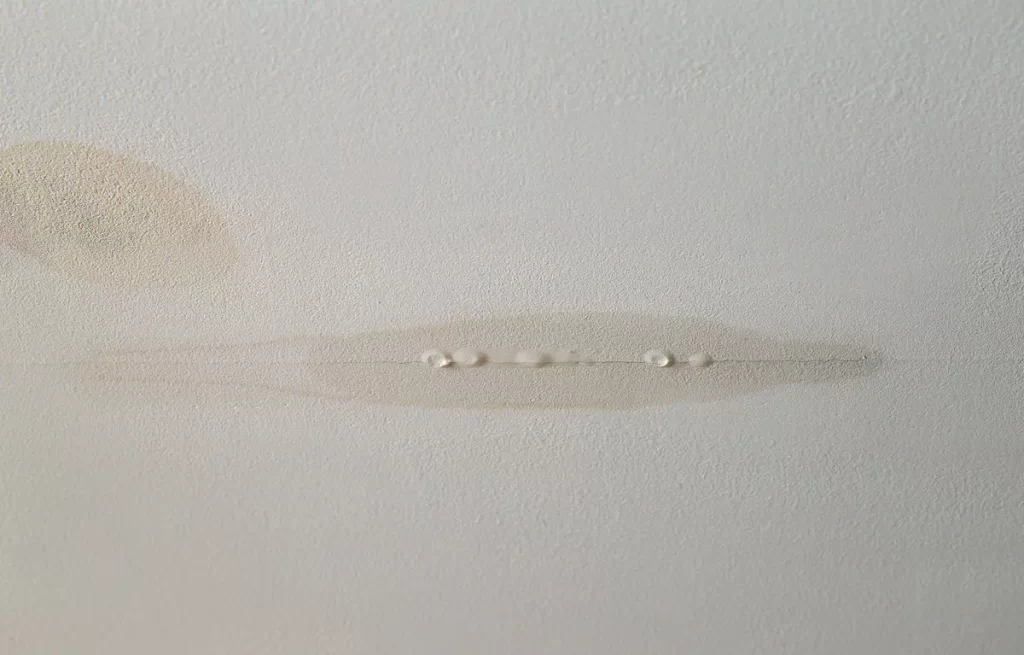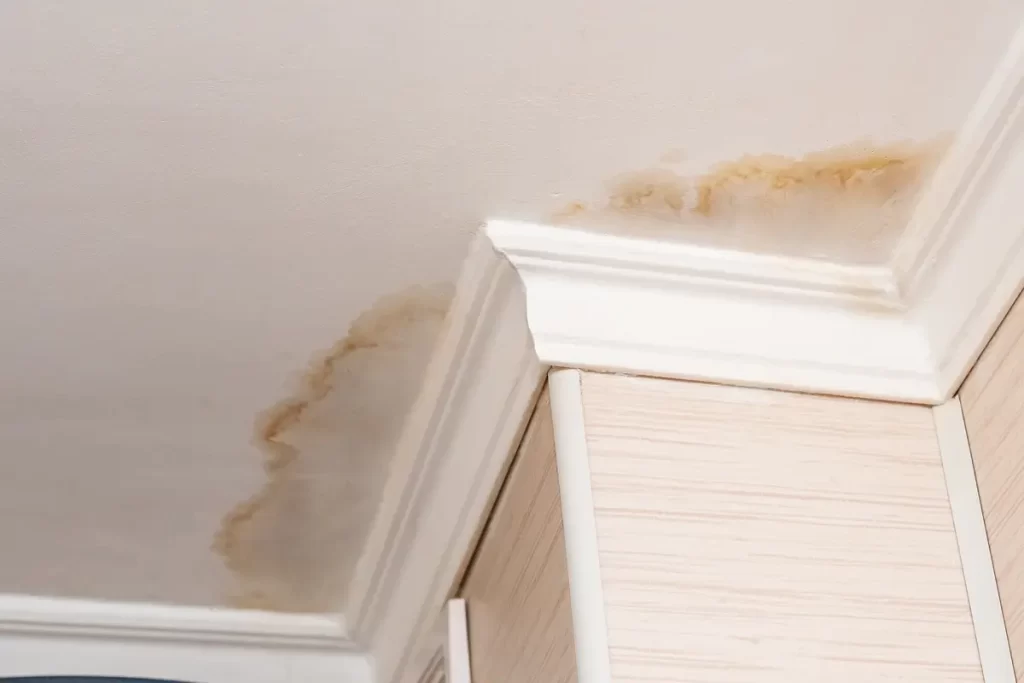Water leaking from ceiling systems is a homeowner’s nightmare. Not only can it cause significant damage to your home, but it can also pose serious health risks if not addressed promptly. This post will walk you through everything you need to know about:
- Identifying
- Addressing
- Preventing ceiling leaks
Understanding Ceiling Leaks

Ceiling leaks can occur for various reasons, and understanding these reasons is essential for effective resolution. A ceiling leak is essentially water from either an internal or external source making its way through your home’s structure and dripping onto your ceiling. This can lead to:
- Unsightly stains
- Weakened structural integrity
- Potential electrical issues if left unchecked
Common Causes of Ceiling Leaks
Wondering what might be causing your ceiling to leak? We’ve broken down the most common causes of a leaky ceiling.
🛁 Plumbing Issues
One of the most common causes of ceiling leaks is plumbing problems. This could be due to a burst pipe, faulty plumbing fixtures, or even leaks in the bathroom. Plumbing leaks often present themselves as localized wet spots on the ceiling directly below the bathroom or kitchen.
🏚️ Roof Problems
Another frequent cause of ceiling leaks is roof damage. This can be due to missing or broken shingles, damaged flashing, or clogged gutters. Roof leaks often result in water entering through the attic and seeping down to the ceiling.
💧 Condensation
Condensation can also lead to ceiling leaks, particularly in homes with poor ventilation. This issue is more common in areas where warm, humid air meets colder surfaces, causing water droplets to form and eventually leak through the ceiling.
How To Identify the Source of the Leak
Once your ceiling starts leaking, it’s important to find the source of the leak as soon as possible. Here’s how to locate a leak like a pro.
- Visual Inspection: Start with a thorough visual inspection. Look for any obvious signs of water damage, such as stains, discoloration, or sagging areas on the ceiling. Don’t forget to check the attic or the area directly above the leak for any telltale signs of moisture or damage.
- Moisture Detection Tools: Moisture detection tools can be invaluable in pinpointing the exact source of a leak. These tools can help you detect hidden moisture in walls and ceilings, ensuring that you identify the full extent of the issue.
- Professional Assessment: If you cannot determine the source of the leak through visual inspection or moisture detection tools, it may be time to call in a professional. A licensed contractor or plumber can perform a more thorough assessment and identify the root cause of the leak.
5 Signs That Your Leak is Coming From the Roof

Identifying whether your leak originates from the roof is critical in ensuring the proper repairs are undertaken. Here are some signs that indicate a roof-related leak:
1) Water Stains and Drips
If you notice water stains or dripping during or right after rainfall, this is a strong indication that your roof may be compromised. Roof leaks are often marked by sporadic dripping rather than continuous moisture, correlating with weather patterns.
2) Damaged or Missing Shingles
Inspect your roof for any damaged or missing shingles. Shingles that are broken, cracked, or completely gone are often a direct pathway for water to infiltrate your home. Regular maintenance and inspections can help catch these issues early.
3) Debris in Gutters
Clogged or overflowing gutters filled with debris can prevent water from properly draining away from your roof. If water cannot escape effectively, it can accumulate and eventually seep through to the ceiling below.
4) Flashing Deterioration
Pay attention to the flashing around chimneys, vents, and skylights. Flashing is crucial for preventing leaks where there are roof penetrations. Deterioration, rust, or dislodged flashing can easily lead to leaks during heavy rainfall.
5) Interior Roof-Space Check
An inspection of the attic or crawl space can reveal signs of roof leaks. Look for wet insulation, mold growth, or light peeking through the roof boards, all of which suggest a breach in your roof’s integrity.
Immediate Steps to Take When You Discover a Leak
Once you realize you have a leaking ceiling, follow these steps to minimize damage.
Contain the Leak
The first step is to contain the leak to prevent further damage. Place a bucket or any large container under the leak to catch the dripping water. If the leak is substantial, consider using multiple containers or even a tarp to protect your flooring.
Protect Your Belongings
Move any furniture, electronics, or other valuables away from the affected area. Water damage can ruin your belongings, and it’s crucial to protect them as soon as you notice a leak.
Turn Off the Water Supply
If the leak is due to a plumbing issue, turning off the water supply can help minimize further damage. Locate the main water shut-off valve and turn it off until you can address the plumbing problem.
Repairing Ceiling Leaks
A roof leak requires different repair methods, depending on what is causing the leak. But you don’t have to handle repairs on your own. Here are our best tips for minimizing damage.
DIY vs. Professional Repairs: While some minor leaks can be fixed with DIY methods, more significant issues often require professional intervention. Consider your skill level and the severity of the leak when deciding between DIY and hiring a professional.
Temporary Fixes: For minor leaks, temporary fixes like applying a waterproof sealant or patching the damaged area can buy you time until a permanent solution is implemented. However, remember that these are just stopgap measures and won’t solve the underlying issue.
Permanent Solutions: Permanent solutions involve addressing the root cause of the leak. For plumbing leaks, this might mean replacing damaged pipes or fixtures. For roof leaks, repairing or replacing damaged shingles and ensuring proper sealing around roof penetrations is essential.
Preventing Future Leaks
Regular maintenance is key to preventing ceiling leaks. This includes periodic roof inspections, checking for signs of wear and tear in plumbing systems, and ensuring that your home is well-ventilated to prevent condensation buildup.
Investing in home improvements can also help prevent future leaks. Upgrading to more durable roofing materials, installing water leak detection systems, and improving insulation are all effective ways to safeguard your home against leaks.
Health Risks Associated with Ceiling Leaks
One of the most significant health risks associated with ceiling leaks is mold and mildew growth. These fungi thrive in damp environments and can cause respiratory issues, allergic reactions, and other health problems.
Ceiling leaks can also lead to structural damage over time. Water can weaken the wooden beams, drywall, and other materials that make up your home’s structure, potentially leading to costly repairs or even compromising the safety of your home.
Insurance and Ceiling Leaks
Understanding your homeowner’s insurance policy is crucial when dealing with ceiling leaks. Many policies cover water damage caused by sudden and accidental leaks but may exclude damage resulting from gradual leaks or lack of maintenance. Review your policy and contact your insurance provider to understand what is covered and how to file a claim.
When to Call a Professional
While some minor leaks can be managed with DIY methods, there are situations where calling a professional is essential:
- Complex Plumbing Issues: If the leak is due to a complicated plumbing problem, it’s best to call a licensed plumber.
- Roof Damage: Significant roof damage or leaks that are difficult to locate should be handled by a roofing professional.
- Mold and Mildew: If mold or mildew is present, a professional mold remediation service is necessary to ensure safe and thorough removal.
- Structural Damage: Any signs of structural damage warrant immediate attention from a licensed contractor or structural engineer.
When Water Is Leaking, You Need Monarch

Dealing with a ceiling leak can be stressful, but knowing how to identify, address, and prevent leaks can make the process much more manageable.
If you have any questions or need professional assistance, don’t hesitate to contact Monarch Roofing. We’re here to help you keep your home safe and dry.





